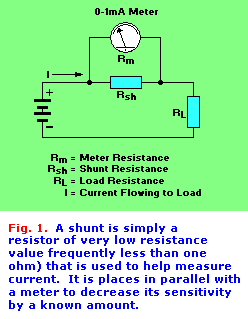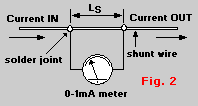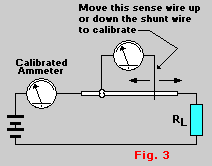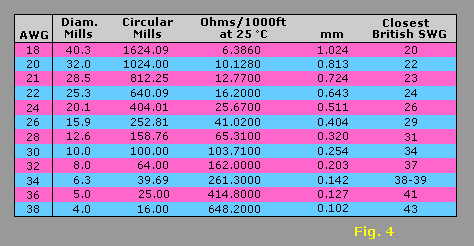Make Your Own Shunts
By Dean F. Poeth, II
"While they might not be as accurate as the commercial units, these easy-to-make
shunts are more than sufficient for many uses, and cost far less."
 Using a modern multimeter to measure
current can sometimes be difficult. Many of these meters will only measure up to one amp. However, may 112-volt
DC powered projects draw a lot more than that. If you have ever thought of purchasing a commercial shunt to solve
the problem, your know just how expensive they can be. Commercial shunts, while very precise, frequently cost more
than the projects they are measuring!
Using a modern multimeter to measure
current can sometimes be difficult. Many of these meters will only measure up to one amp. However, may 112-volt
DC powered projects draw a lot more than that. If you have ever thought of purchasing a commercial shunt to solve
the problem, your know just how expensive they can be. Commercial shunts, while very precise, frequently cost more
than the projects they are measuring!
However, there is a better and cheaper alternative that will work perfectly well in most situations: With only a few
cents worth of wire and a little know-how, you can make your own shunts. It only takes a few minutes, and it's fun!
What is a shunt: A shunt is simply a resistor of very low value (frequently less than one ohm) that is used
to help measure current. As shown in Fig. 1., the shunt resistor Rsh is placed in parallel with a meter
to decrease its sensitivity by a known amount. The shunt does that by bypassing or "shunting" most of the current
around the meter. The shunt resistor there fore lets your take a standard meter, such as a 0-1miliammeter, and
turn it into, say, a 0-20-amp meter.
The Shunt Meter: Before you can make a shunt, you must find a suitable shunt meter. Surplus analog meters can
be found at hamfests or mail-order sources for only a few dollars each, and they make excellent shunt meters. For a
list of mail order sources of surplus analog meters, as well as new ones, see the sidebar.
When selecting a meter, try to pick a 0-1mA meter in good physical condition and one with a convenient scale on the
faceplate. For example, if you need the meter to read 10-amps full scale, then select a meter graduated from 0-1.
If you need a full scale reading of 30 amps, select one with a 0-3 graduation. This way the job is easy!
To make a shunt, your will need to know the internal resistance of your meter. Therefore, select a unit that has its
internal resistance printed on it, most likely in small letters on the meter face or on the back near the terminals.
If you already have a meter on hand but do not know its internal resistance, there is a simple way it can be determined.
If you have a modern digital multimeter, set it to its highest resistance range. Connect the multimeter's red
(positive) lead to the positive analog meter terminal and the black (common) lead to the analog meter's negative
terminal.
Digital multimeters measure resistance by passing a small amount current through the device under test. Do not attempt
to use an analog multimeter to make this measurement. These older multimeters use much more current to test
resistance, enough to potentially destroy some mA meters.
Watching your analog meter, work your way down the DMM's resistance ranges (remember you began at the highest range)
until the analog meter's needle moves to a full-scale reading. Note the reading on your DMM, and write it on the
back of the meter using a permanent marker. Be careful and take your time. If you go too fast and accidentally pin
the meter, it could easily be damaged.
(Tony's Note: I checked a dozen or so meters of different variety and found that this method of measuring the
internal resistance of a particular meter is flawed and does not always work. Best is to obtain a meter with this
resistance (Ri) written somewhere on the meter.)
Making the Shunt: The shunt is made from a short length of copper wire. All wire has resistance, so we can
use that property to make a shunt resistor. To make a shunt, you first need to determine how much current will flow
through it. For example, if your meter is going to measure 20 amps full scale, then the shunt wire must be safely
able to carry that amount of current.
Let's say you are going to make a 20-amp shunt using a surplus analog 0-1 milliammeter (mA) whose face plate is
graduated from 0-1. Go to a copper-wire table (there is one in every ARRL HANDBOOK for Radio Amateurs; if
you don't have a copy, it is available at almost any public library) and select an appropriate gauge wire. Remember
that the smaller the wire gauge, the more current it can safely carry. For most hobby applications, 250 circular
mils per amp is more than adequate.
To find the circular mils per amp for the shunt wire, divide the circular mils for the selected wire (found in the
copper wire table) by the current you intend to pass through the wire:
Circular Mils per amp = (circular mils for wire) / (current through the wire)
(Eq. 1)
By using the copper wire table, you will find that 12-gauge wire has a cross-sectional area of 6530 circular mils.
By dividing that by 20 amps, we get 326 circular mils/amp, which should work fine. 12 gauge wire is very common, and
can be purchased in most hardware stores.
To find the resistance of the shunt, use this equation:
Rsh=Rm / (n-1) (Eq. 2)
Where Rsh is the resistance of the shunt, Rm is the resistance of the surplus meter, and n is the shunt's
multiplication factor. In our example, since we are using a 0-1mA meter and 1 mA=0.001amps, n=20amps / 0.001amps,
or 20,000.
Next, let's suppose that the resistance of your meter was 81 ohms. Plugging that resistance and n=20,000 into
equation 2 (Eq.2) yields:
Rsh = 81 / 20,000 - 1) = 0.00405 Ohms.
That's not very much resistance, is it! A shunt having that resistance will pass 19.999 amps through it, and 0.001A
(1 mA) will pass through the meter for a full scale reading.
Next, we need to calculate the lenth of our copper wire shunt. Note that as stated in the copper-wire table, 12 gauge
wire has a resistance of 1.619 ohms/1000ft. Therefore, the length of the shunt wire (Ls) can therefore be
determined using:
Ls=Rsh / (XV/1000ft.) = 0.00405 / (1.619/1000ft.) =
2.5 ft.
So the 12-gauge wire shunt should be 2 feet 6 inches long when using a 0-1mA meter having an internal resistance of
81 ohms to measure 20 amps full-scale.
If we made this shunt too long, however, we might have trouble with contact resistance. That is because even a good
solder joint has a lot of resistance when compared to a 0.00405-ohm shunt. To make sure that the circuit's contact
resistance is not part of the shunt resistance, two sense wires may be used. These sense wires are spaced
Ls apart on the shunt wire as shown in Fig. 2. Any type of wire may used
for the sense wires; they are noncritical. This simple feature will greatly increase the accuracy of your shunt.
Now we are ready to make our shunt. Cut a length of 12-gauge solid copper wire (also called Magnet Wire) about
3-feet long. Remove the insulating coating from the wire with a hobby knife or sand paper, being careful not to nick
it. Now measure about 2 inches from one end and solder one sense wire there. Carefully measure 2 ft 6 inches from
that sense wire and solder the second sense wire in position. Connect the shunt to its meter as shown in fIg. 2, and
you're ready to measure current! If you want to make the shunt a little more compact, you can wind it over an
insulated screwdriver handle, or something similar, such as a non-conductive wood dowel.


Calibrating the Shunt: Shunts made using this method can be very accurate. However, improved accuracy can be
achieved by calibrating the shunt to a known standard, i.e. a calibrated meter. To do this, build the circuit shown
in Fig. 3. Make sure that the load resistance, RL, can safely handle the power. I have found that car
tail light lamps make a convenient load for the circuit.
To calibrate the shunt, solder one sense wire into position as described above. Power up the circuit and slide the
second sense wire up and down the shunt wire until you find the spot where the shunt meter reads the same current as
the calibrated meter. Remove power from the circuit and solder the second sense wire at that spot.

The table above Fig. 4. shows the most common wire types I use myself. If you need other AWG or wire
information I suggest to purchase the ARRL Radio Amateur Handbook. It contains a HUGE treasure of all kinds of
information. I will answer no emails in regards to the Copper Wire Specifications. Buy the ARRL Handbook, you will
be impressed!
Conclusion: Using these methods you can make shunts for almost any range of DC currents. What's more,
with a little care your should be able to make shunts accurate to within 5-10% if you keep them near room temperature.
Of course, these shunts are not nearly as precise or temperature-stable as the commercial versions. Still, if you
need one for a non-demanding application(like a variable power supply), or just want to have some fun, grab a few
cents worth of wire and make your own shunt!
I fully support this project, since my unit has been in operation for quite a few years now and still
using the same battery. Most parts can be obtained via your local electronics store. I will answer all questions but
via the message forum only. Tony's Message Forum can be accessed via the main page, gadgets, or
circuits page.
Copyright and Credits:
Source: "Electronics Now", August 1998, page 51. Copyright © Dean F. Poeth II,
Ph.D.,K8TM and
Gernsback Publications, Inc. 1998. (Gernsback Publishing no longer exists).
Document updates & modifications, all diagrams, PCB/Layout drawn by Tony van Roon.
Re-posting or taking graphics in any way or form of this project is expressily prohibited by international
copyright laws.
Page Copyright © 1995 - Tony van Roon, VA3AVR
Project Copyright © 1994, by Dean F. Poeth II


 Using a modern multimeter to measure
current can sometimes be difficult. Many of these meters will only measure up to one amp. However, may 112-volt
DC powered projects draw a lot more than that. If you have ever thought of purchasing a commercial shunt to solve
the problem, your know just how expensive they can be. Commercial shunts, while very precise, frequently cost more
than the projects they are measuring!
Using a modern multimeter to measure
current can sometimes be difficult. Many of these meters will only measure up to one amp. However, may 112-volt
DC powered projects draw a lot more than that. If you have ever thought of purchasing a commercial shunt to solve
the problem, your know just how expensive they can be. Commercial shunts, while very precise, frequently cost more
than the projects they are measuring!

